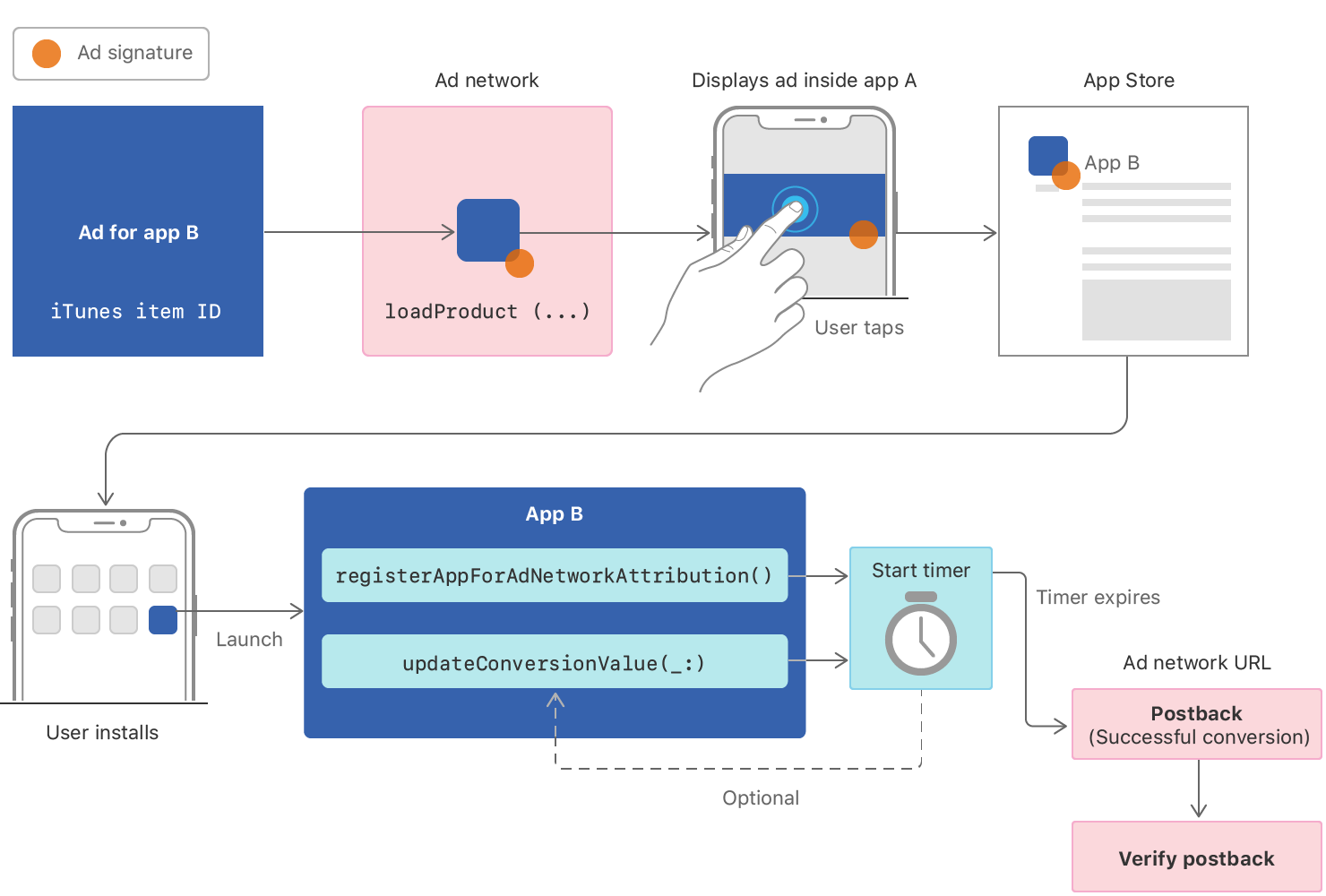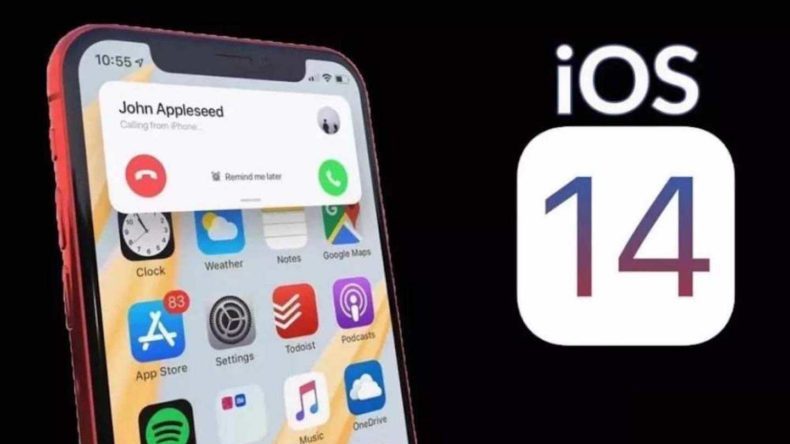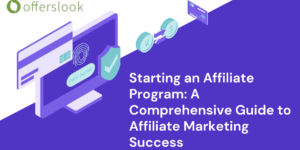Due to the inability to obtain accurate user IDFA, which led to problems such as advertiser attribution and information sharing, Apple relaunched SKAdNetwork 2.0 as an alternative to attribution.
So what is SKAdNetwork 2.0?
In simple terms, the advertising platform needs to register as an advertising network of Apple and provide a callback address. After the user downloads and opens the advertiser’s APP through the advertisement of this advertising network, Apple will send installation and other information to the postback address. SKadnetwork is actually Apple’s overall plan for non-IDFA installation and conversion attribution, which can only be achieved through the participation of advertising platforms, advertisers, and media. The re-launched SKAdNetwork adds some integrate parameters and interfaces.
SKAdNetwork process diagram, picture from Apple:

When the user clicks on the advertisement, an APP Store product interface with signature information is displayed, and the signature information marks the advertising campaign. If the user installs and opens the APP, the device sends an installation verification notification to the advertising network. This notification, signed by Apple, includes the campaign ID, but does not contain user or device-related data. The notification can also include a conversion value and source application ID, which depends on a privacy threshold set by Apple.

Explain the relationship between SKAdNetwork and IDFA in general:
SKAdNetwork’s model: For example, when you go to a theater to watch a movie, from buying a ticket (click) to admission (installation), this ticket (Ad Signature) does not have any personal information about you. The ticket office is equivalent to an advertising platform, and you only know the ticket Where is it sold, how much is it sold, which channel is sold, whether to watch the movie, and when. However, the ticketing system does not know the specific characteristics of the person who bought it, such as whether he bought popcorn, age, gender, and whether he was single.
IDFA model: For example, if you travel abroad with a group tour, your passport, certificate of deposit, etc. (IDFA) are taken away by the travel agency, so all your privacy can be taken out by the travel agency for various promotions, for example, the travel agency knows whether you have consumed or made purchases , Age, gender, which countries have been visited before, etc., that to determine what type of user you belong to, and then push more ads to you.
Although Apple re-issued a statement on September 3, 2020, postponing the implementation of the requirement for application tracking to obtain user permissions early next year, but it has become a trend that advertisers are prohibited from directly obtaining IDFA. If you need to know the specific statement, please visit Apple’s official link as follows:
Part 2 What challenges will happen from it?
Before iOS13 version, the user’s IDFA was turned on by default, and ads can accurately obtain and share user information to facilitate the remarketing and retargeting, thereby greatly improving the marketing effect of mobile advertising. Due to the accuracy and timeliness of IDFA, it is possible to monitor in real time whether channel providers have traffic cheating. However, after the re-launch of SKAdnetwork, it is closed by default, unless the user is willing to accept the ad push and chooses to open it.
Here is the following challenges will happen in the future:
1. Postback delay: SKadnetwork is currently only allowed to send device or user identification information once in 24 to 48 hours. In this way, the network receives a proof that an installation has occurred, without the need to bind the installation to a specific Users, thereby protecting privacy;
However, for advertisers, the time-sensitive assistance is lost, which means that CTIT (from user download to attribution, an important judgment indicator) is invalid, and advertisers cannot determine whether there is cheating in clicks in a timely manner within 24 hours, that will reduce the trust of advertisers.
2. Attribution impact: At present, many attribution service 3rd party platforms, such as Appsflyer, it will try to use fuzzy attribution methods. Although three auxiliary parameters are provided to help attribution, they are still far from the accuracy of IDFA.
{lang}-language of the device
{af_ ua}-user agent
{af_ip}-IP of the device
3. Advertising cheating: Because the fuzzy attribution method has the problems of low difficulty in changing and high degree of overlap, it is more prone to advertising cheating. Due to the lack of UUID, it becomes more difficult for advertising service providers and advertisers to remarket and retarget at the granularity of devices and users.
Part 3 How does Offerslook help users solve the core issues?
For third-party platforms that serve affiliate network users, the main core is to help users solve the problem of correct connection of parameters and accurate data tracking. Avoid the upgrade of IOS14, which affects the connection of users, thereby affecting business flow, reconciliation and checkout issues.
At present, the Offerslook platform actively responds to the iOS14 integrate issues raised by users, contacting multiple advertiser’s platforms to obtain their solutions, and actively responding to future integrate issues.
For more details, please contact Offerslook: sales@offerslook.com

Part 4 Thinking points about future problems
For advertisers, the main problem currently facing is the ability to obtain attributions with relative accuracy. If the collection of idfa is banned by users, it involves remarketing and retargeting, which makes it more difficult for advertisers to obtain accurate users, which also means the cost of acquiring accurate users has become higher, although authorized users can still follow the previous method, how many authorized users can there be? That will be an intertersting question to be explored.
For tracking platform, if advertisers continue to fire click id for unauthorized users of IOS, which may violate Apple’s policy and cause the developer’s product to be taken down. Will third-party attribution services such as public fingerprints and UUID consensus algorithms continue to be derived? It seems it will continue to adjust with the policy in the future.
In addition, due to changes in parameter integrate and changes in attribution logic, as Apple promotes these policies, will Android system soon launch corresponding policies?
SKAdnetwork still faces many questions to think about in the future, welcome to join your discussion:
1. Can SKAdNetwork provide the precise data required for efficient decision-making?
2. How to use deep link in SKAdNetwork?
3. How to prevent cheating in the new environment?
4. What is the opt-in rate of users?









